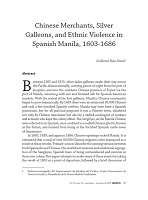Chinese Merchants, Silver Galleons, and Ethnic Violence in Spanish Manila, 1603-1686
DOI:
https://doi.org/10.32870/mycp.v12i36.330Abstract
Between 1565 and 1815, silver-laden galleons made their way across the Pacific almost annually, carrying pieces-of-eight from the port of Acapulco and into the southern Chinese province of Fujian via the port of Manila, returning with raw and finished silk for Spanish American markets. With the arrival of the first galleons, Manila’s Chinese community began to grow dramatically. By 1603 there were an estimated 30,000 Chinese and only a few hundred Spanish settlers. Manila may have been a Spanish possession, but for all practical purposes it was a Chinese town, inhabited not only by Chinese merchants but also by a skilled contingent of workers and artisans who kept the colony afloat. The Sangleyes, as the Manila Chinese were referred to in Spanish, were confined to a walled Chinese ghetto, known as the Parián, and banned from living in the fortified Spanish castle-town of Intramuros. In 1603, 1639, and again in 1686, Chinese uprisings rocked Manila. It is estimated that a total of over 40,000 Chinese migrants were massacred as a result of these revolts. Primary sources describe the existing tension between both Spaniards and Chinese: the exorbitant taxation and residential segregation of the Sangleyes; Spanish fears of being outnumbered and overrun in their own colony. This paper attempts to make sense of these events by taking the revolt of 1603 as a point of departure, followed by a brief discussion of the underlying causes of ethnic violence in Spanish Manila. It then explores the background of Manila’s economic and social structures in order to analyze the Sangley uprisings of the seventeenth century within the context of colonial Manila’s role as the multiracial entrepôt of the trans-Pacific galleon economy. It was in 1603 that the governor of Fujian, under imperial decree, dispatched the assistant magistrate of the port of Haicheng ?? to meet with the chieftain of the so-called Spanish “barbarians” (or xiao xiyang ???). He sailed with a retinue of over a hundred men, and once he met with the governor of Manila, proceeded to inquire about a legendary mountain made of gold allegedly adjacent to Manila Bay, rumors of which had reached as far as the emperor.Downloads
References
Amyot, Jacques, The Manila Chinese: familism in the Philippine environment, 2nd ed., Institute of Philippine Culture/Ateneo de Manila University, Quezon City, 1973.
Atwell, William, “International Bullion Flows and the Chinese Economy,” Past and Present, No. 95, 1977, pp. 68-90.
Bjork, Katharine, “The Link That Kept the Philippines Spanish: Mexican Merchant Interests and the Manila trade, 1571-1815,” Journal of World History, Vol. 9, No. 1, 1998, pp. 25-50.
Blussé, Leonard, “Chinese Century: The Eighteenth Century in the China Sea Region,” Archipel, No. 58, 1999, pp. 107-129.

Downloads
Published
How to Cite
Issue
Section
License
Open Access Policy
This journal provides open access to all its contents, in adherence to the principle that making research freely available supports a greater global exchange of knowledge.
MyCP is licensed under a Creative Commons Attribution-NonCommercial license, also known as CC BY-NC.
Contents are published in both PDF and XML formats.
Authors who publish in México y la Cuenca del Pacífico must accept the following conditions:
Pursuant to Mexican copyright laws, México y la Cuenca del Pacífico acknowledges and respects the authors’ moral right and ownership of property rights, which will be assigned to the University of Guadalajara to publish the articles in an open-access mode.
México y la Cuenca del Pacífico does not charge the authors any fees for receiving and processing their articles.
Authors are permitted to enter into other independent and additional contractual agreements for the non-exclusive distribution of the article version published in México y la Cuenca del Pacífico (for example, publishing it in an institutional repository or in other printed or electronic media) as long as they clearly state that the piece was originally published in México y la Cuenca del Pacífico.
Pursuant to the above, once the article is approved for publication, authors must send the Assignment of Rights Agreement form duly filled and signed. This form must be sent to mexicoylacuenca@gmail.com as a PDF file.
Readers/users of México y la Cuenca del Pacífico can freely access the journal new issues as soon as they are uploaded. Readers/users are allowed to cite, share (both electronically and physically), print and distribute the material, provided they expressly state that the work was originally published in México y la Cuenca del Pacífico. Contents are to be properly cited and never for commercial purposes.




